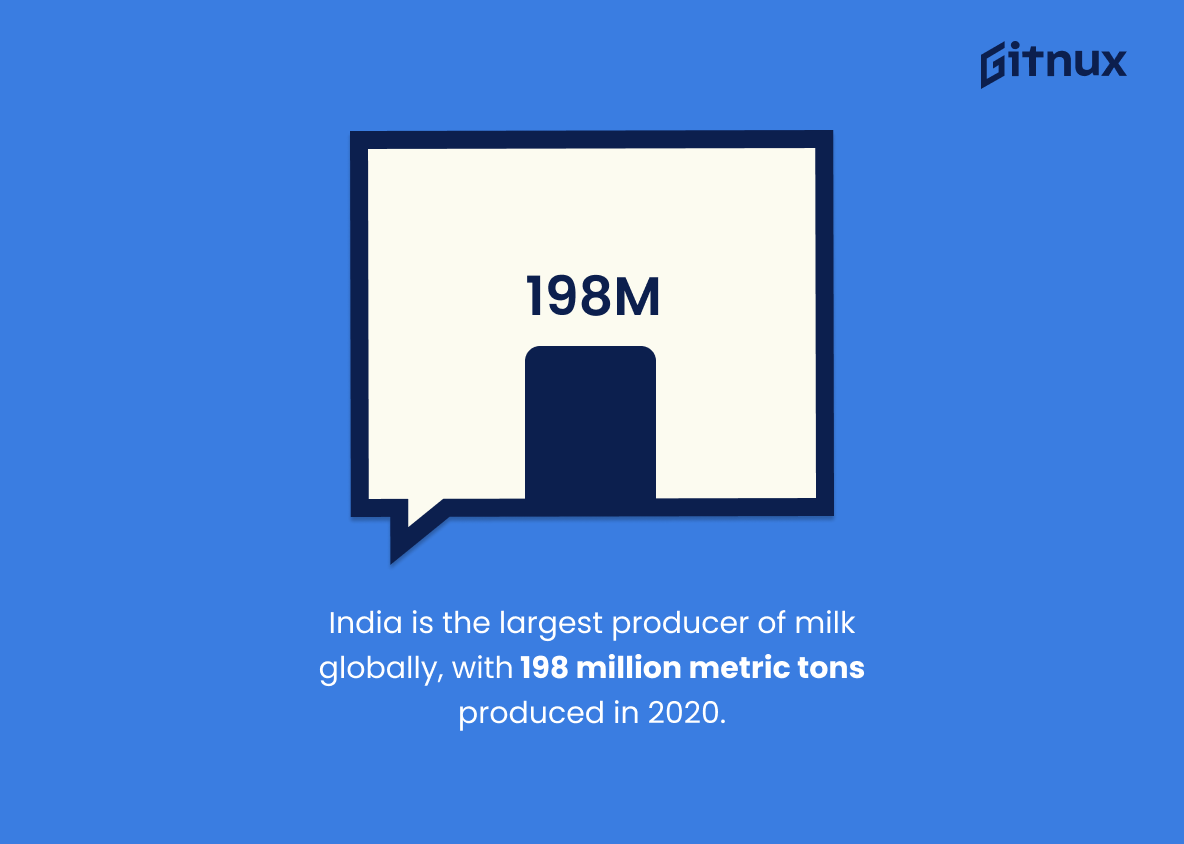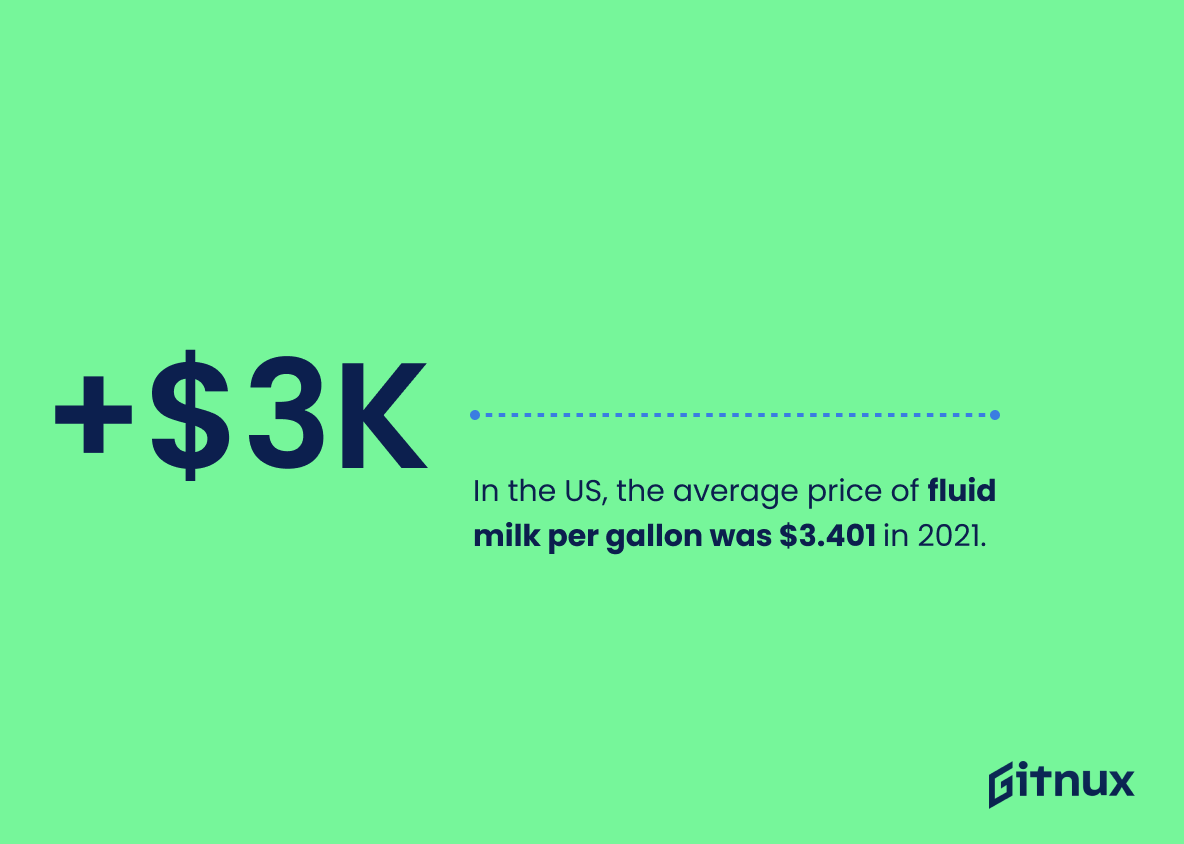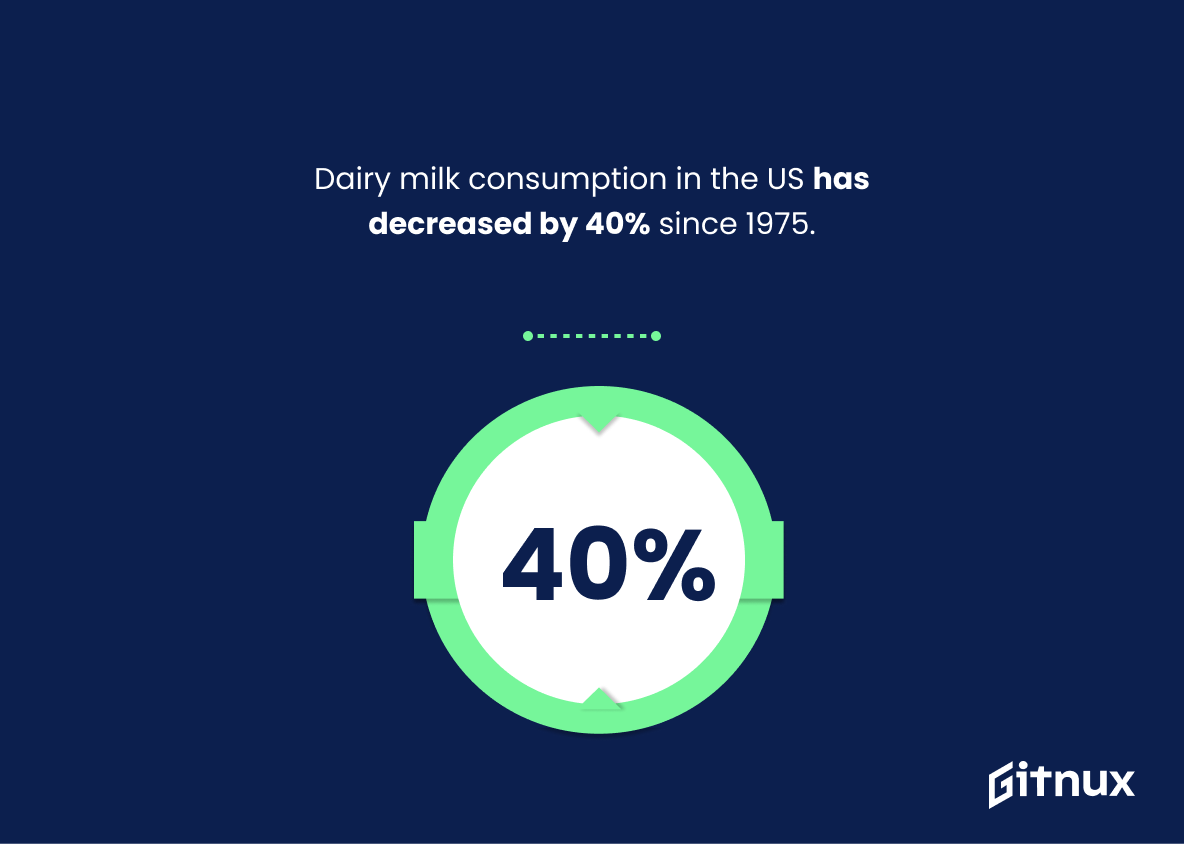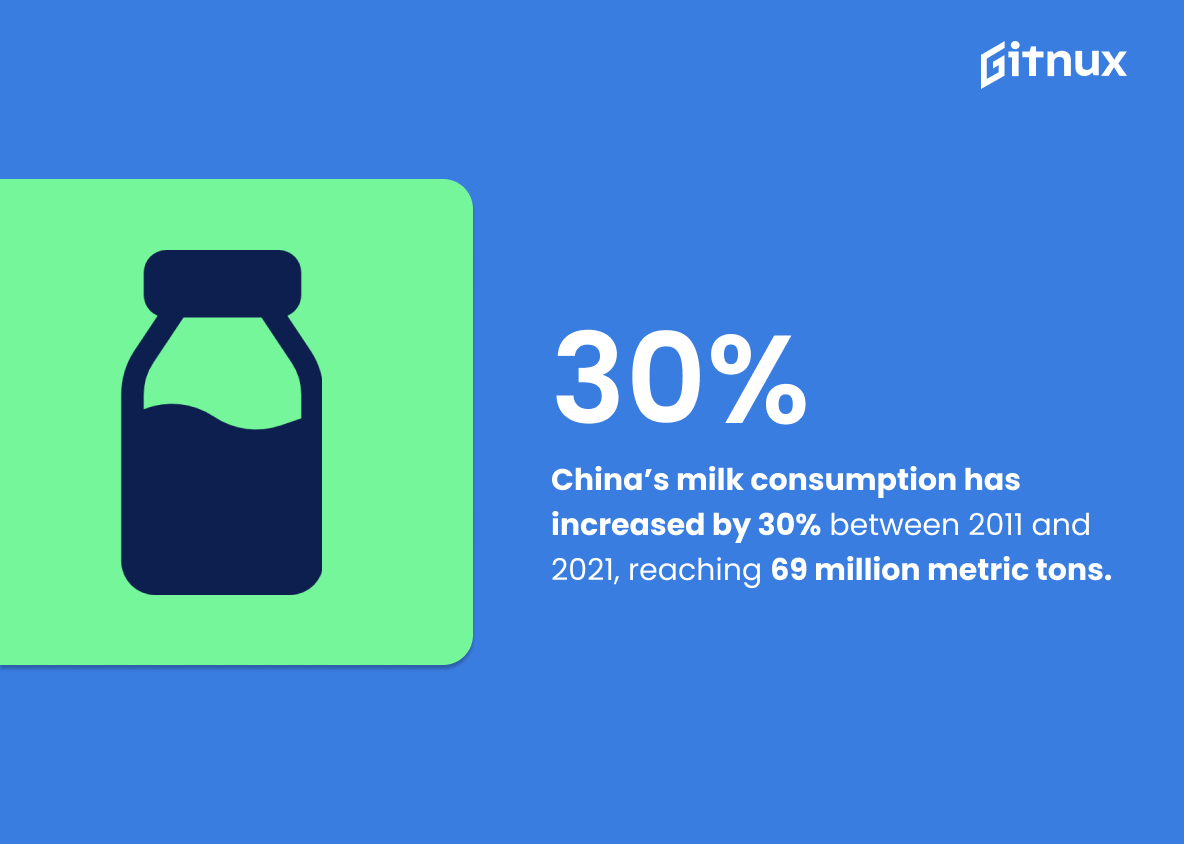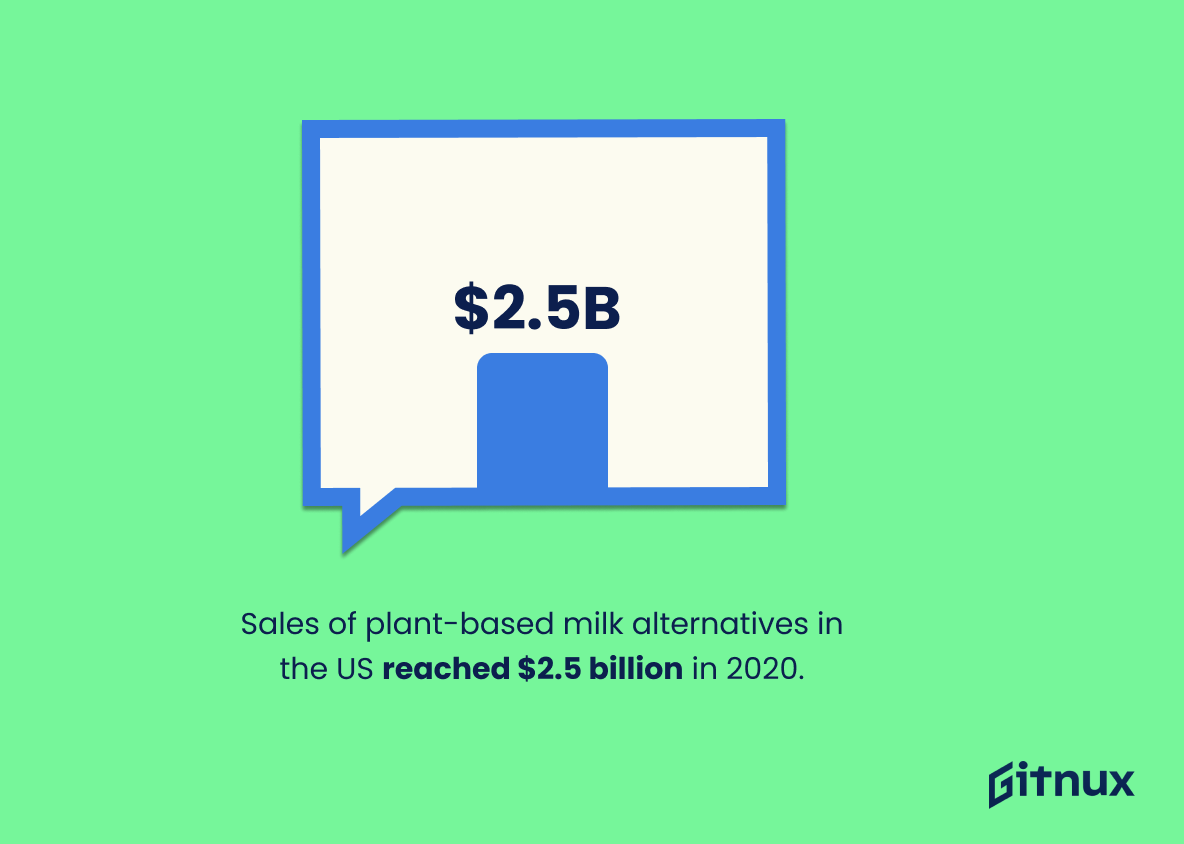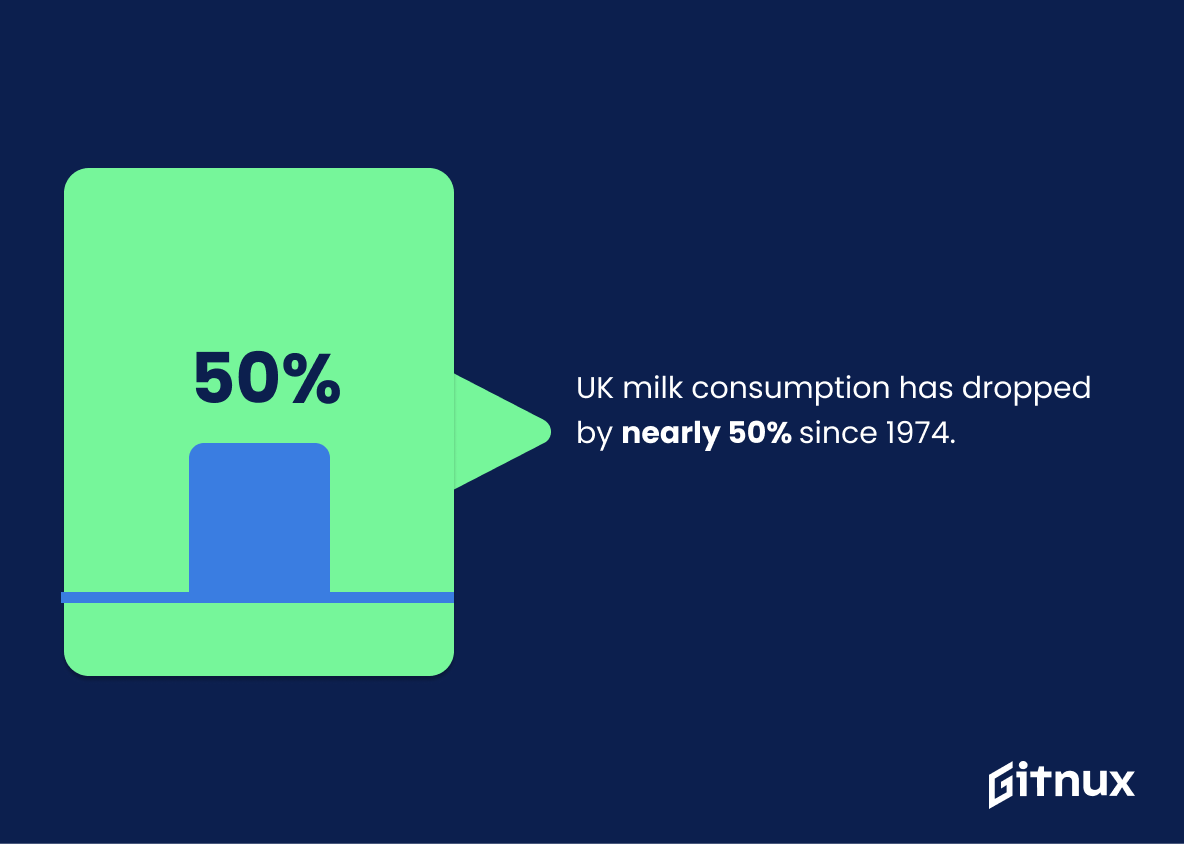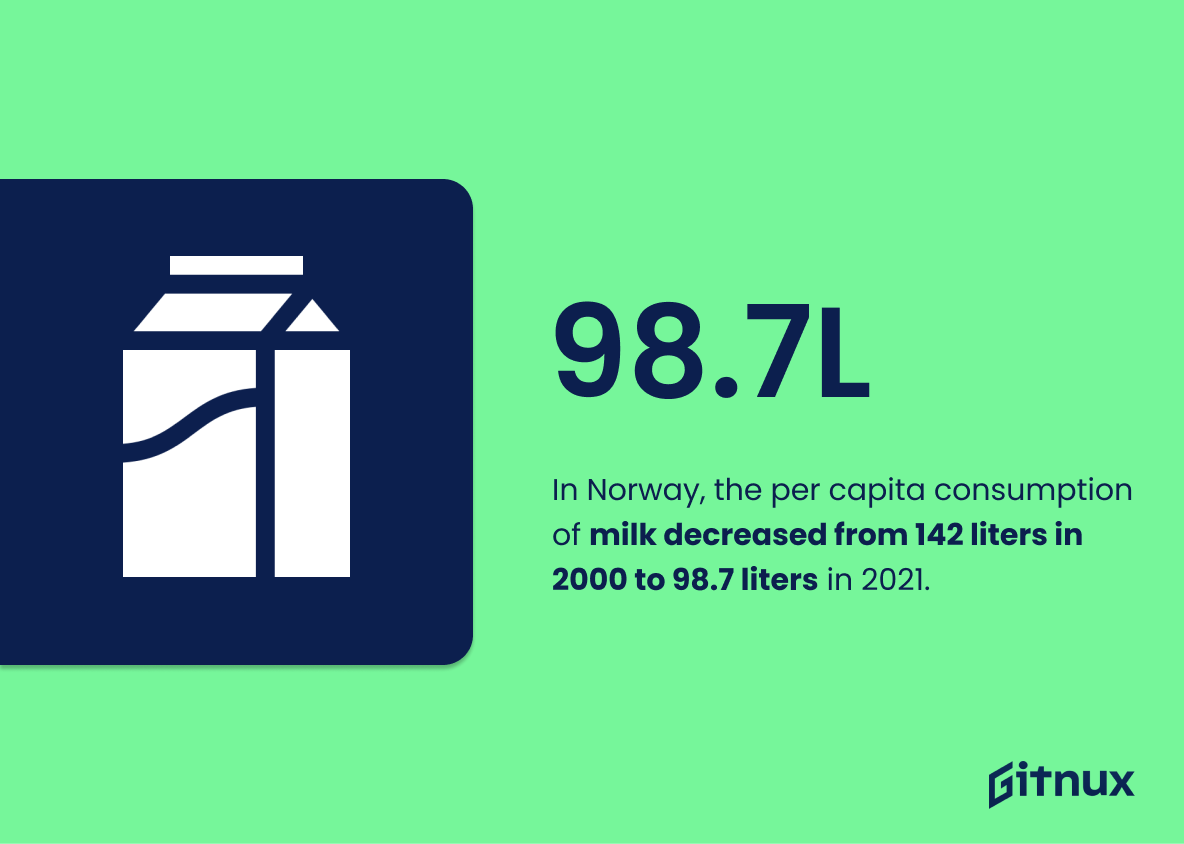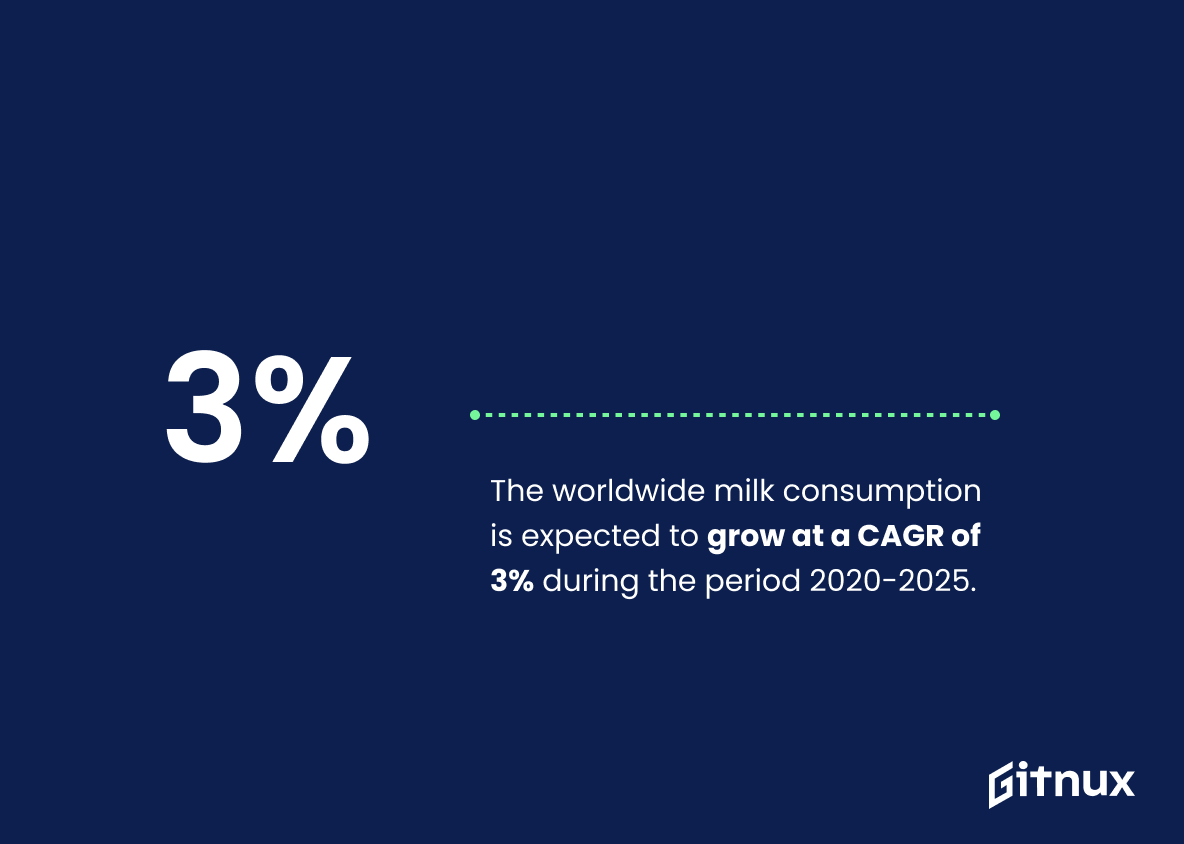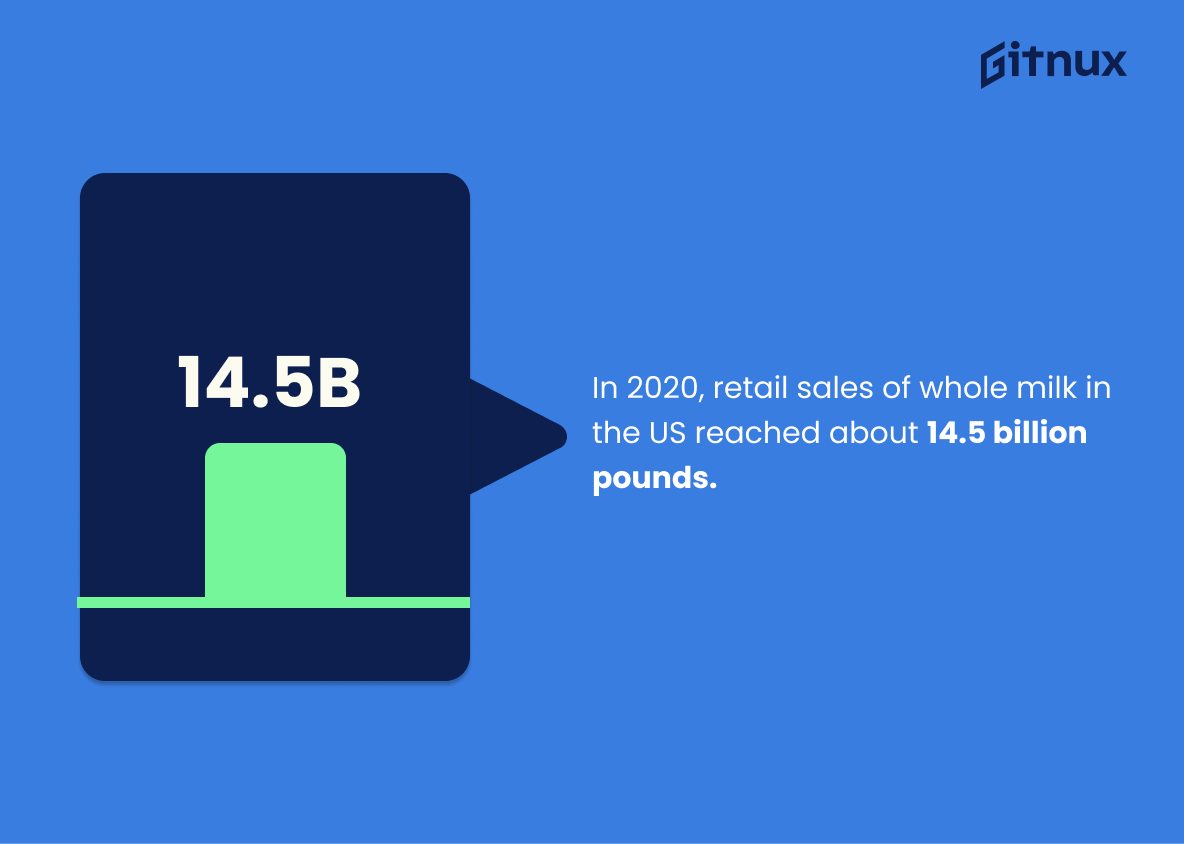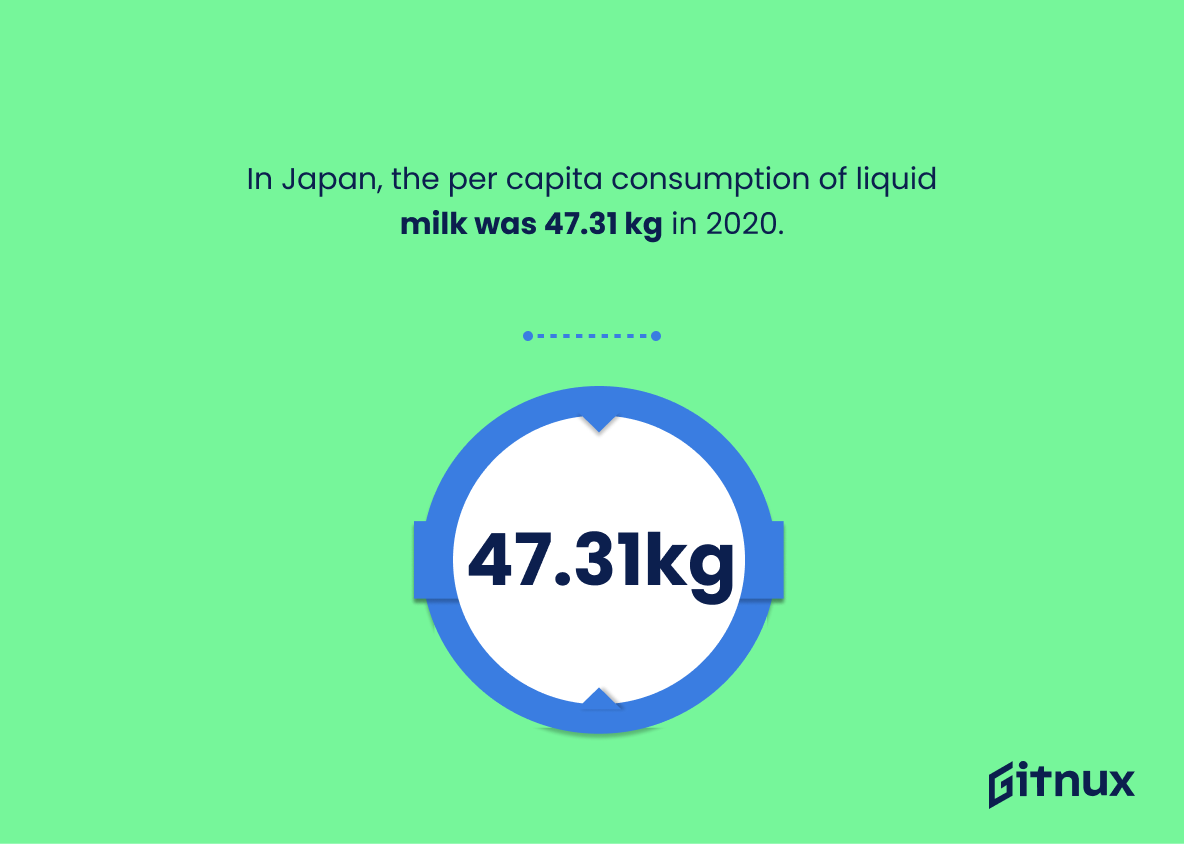Milk is a staple in many diets around the world, and its consumption has been steadily increasing over time. According to Statista, global milk consumption was estimated at 908 billion liters in 2021. In the United States alone, per capita milk consumption reached 146 kg in 2019 according to data from The World Bank. Finland had the highest per capita milk consumption globally with 361 kg of fluid milk consumed by each person on average during 2018 as reported by FAOStat. India led all countries for total production of 198 million metric tons of fluid milk produced in 2020 based on statistics from Statista.
In terms of pricing, US consumers paid an average price of $3.401 per gallon for fluid cow’s milk while almond-based alternatives saw sales reach $5.2 billion worldwide according to Grand View Research and Nielsen respectively; however dairy cow’s milks’ popularity has decreased 40% since 1975 due to plant-based alternative options such as soy or oat milks which have seen retail sales reach 2$5 billion within the US market last year (Nielsen). Additionally 65% percent human population lack lactase enzyme after infancy making them unable digest lactose found naturally occurring within most types cows’milk products (NIH). Furthermore UK experienced nearly 50% decrease their liquid cow’s mill consumptions since 1974(BBC) whereas Australians averaged 105 liters/person 2018(Dairy Australia), Canadians 1775 liter/person 2020(Statistics Canada) , Japanese 4731kg/person2020 (OECD )respectively .Organic Cow’s Milk Sales also increased reaching 1$4billion 2019 U S Market (OTA ). Global demand goat mill expected grow CAGR 11 % 2026 ($1554 Billion)(Allied Market Research ),while Worldwide Lactose Free Mill Markets projected increase CAGR 11 %2028.(Report Linker). Finally Global Consumption Fluid Milks forecasted rise 3 % 2025 period.(NCBI PMC ).
This statistic is a powerful indicator of the immense impact milk consumption has on the global economy. It speaks to the sheer volume of milk being consumed around the world, and the importance of this commodity in our lives. It is a testament to the fact that milk is an essential part of our diets, and its consumption is only increasing. This statistic is a valuable insight into the current state of milk consumption, and its implications for the future.
The per capita consumption of milk in the United States in 2019 was 146 kg.
This statistic is a telling indication of the importance of milk in the United States. It shows that milk is a staple in the American diet, with each person consuming an average of 146 kg of milk in 2019. This statistic is a valuable insight into the dietary habits of Americans and provides a useful reference point for further research into milk consumption.
Milk Consumption Statistics Overview
Finland has the world’s highest per capita milk consumption, at 361 kg per person in 2018.
This statistic is a testament to Finland’s commitment to dairy consumption, highlighting the country’s dedication to the product. It is a remarkable achievement that speaks to the importance of milk in the Finnish diet, and serves as an example for other countries to follow.
India is the largest producer of milk globally, with 198 million metric tons produced in 2020.
This statistic is a testament to India’s impressive dairy industry, highlighting the country’s ability to produce a staggering amount of milk each year. It is a powerful reminder of the importance of milk consumption in India, and serves as a reminder of the potential for growth in the industry. Furthermore, it provides a valuable insight into the global milk production landscape, and can be used to inform decisions about the future of the industry.
In the US, the average price of fluid milk per gallon was $3.401 in 2021.
The statistic of the average price of fluid milk per gallon in the US being $3.401 in 2021 is an important indicator of the cost of milk consumption. This figure can be used to gauge the affordability of milk for consumers, and can be used to compare the cost of milk in different regions or over time. It can also be used to assess the impact of government policies or other factors on the cost of milk. This statistic is therefore a valuable tool for understanding the dynamics of milk consumption in the US.
The global almond milk market size was valued at $5.2 billion in 2019.
This statistic is a testament to the growing popularity of almond milk, highlighting its immense market value in 2019. It is a clear indication that almond milk is becoming an increasingly popular choice for those looking for dairy-free alternatives. This statistic is an important piece of information for anyone interested in learning more about milk consumption statistics.
Dairy milk consumption in the US has decreased by 40% since 1975.
This statistic is a stark reminder of the changing landscape of dairy milk consumption in the US. It highlights the fact that dairy milk consumption has drastically declined over the past four decades, indicating a shift in consumer preferences and habits. This statistic is an important piece of information to consider when discussing milk consumption statistics, as it provides insight into the current state of the industry.
China’s milk consumption has increased by 30% between 2011 and 2021, reaching 69 million metric tons.
This statistic is a testament to the growing importance of milk consumption in China. It shows that over the past decade, the Chinese have become increasingly reliant on milk as a dietary staple, with consumption rising by a staggering 30%. This is a significant milestone, and one that speaks to the changing dietary habits of the Chinese people.
Sales of plant-based milk alternatives in the US reached $2.5 billion in 2020.
This statistic is a testament to the growing popularity of plant-based milk alternatives in the US. It shows that more and more people are turning away from traditional dairy milk and embracing plant-based alternatives, which is a trend that is likely to continue in the future. This is an important statistic to consider when discussing milk consumption statistics, as it provides insight into the changing preferences of consumers.
Approximately 65% of the human population has reduced lactase production after infancy, affecting their ability to digest lactose in milk.
This statistic is a crucial piece of information when it comes to milk consumption statistics, as it highlights the fact that a large portion of the population is unable to digest lactose in milk. This means that for those individuals, consuming milk can be difficult and potentially lead to digestive issues. As such, this statistic is an important factor to consider when discussing milk consumption.
UK milk consumption has dropped by nearly 50% since 1974.
This statistic is a stark reminder of the drastic decline in milk consumption in the UK since 1974. It serves as a powerful indicator of the changing dietary habits of the British public, and highlights the need for further research into the causes of this decline. It is also a timely reminder of the importance of promoting healthy eating habits and the need to ensure that milk remains an important part of the British diet.
The annual sales of organic cow’s milk in the US reached $1.4 billion in 2019.
This statistic is a testament to the growing popularity of organic cow’s milk in the US. It shows that more and more people are choosing to purchase organic cow’s milk, which is a healthier and more sustainable option than conventional cow’s milk. This is an important trend to note, as it indicates that consumers are becoming more aware of the benefits of organic milk and are willing to pay a premium for it. This is an encouraging sign for the future of milk consumption in the US.
In Norway, the per capita consumption of milk decreased from 142 liters in 2000 to 98.7 liters in 2021.
This statistic paints a vivid picture of the changing landscape of milk consumption in Norway. It shows that over the past two decades, the average Norwegian has been drinking less and less milk, indicating a shift in dietary habits. This could be due to a variety of factors, such as health concerns, environmental awareness, or simply a preference for other beverages. Whatever the cause, this statistic is a valuable insight into the current state of milk consumption in Norway.
Canada’s per capita consumption of homogenized milk was 17.75 liters in 2020.
The fact that Canada’s per capita consumption of homogenized milk was 17.75 liters in 2020 is a telling statistic that speaks volumes about the nation’s dairy consumption habits. It shows that Canadians are still drinking a significant amount of homogenized milk, despite the rise of other dairy alternatives. This statistic is important to consider when discussing milk consumption trends, as it provides a snapshot of the current state of the market.
The worldwide milk consumption is expected to grow at a CAGR of 3% during the period 2020-2025.
This statistic is a crucial indicator of the future of milk consumption, providing insight into the potential growth of the industry. It is essential for anyone interested in the dairy industry to be aware of this statistic, as it can help inform decisions about investments, production, and marketing strategies. Furthermore, this statistic can be used to compare the growth of milk consumption to other food and beverage products, allowing for a better understanding of the overall market.
In 2020, retail sales of whole milk in the US reached about 14.5 billion pounds.
The statistic that retail sales of whole milk in the US reached about 14.5 billion pounds in 2020 is a telling indication of the nation’s milk consumption habits. It is a clear sign that Americans are still drinking plenty of milk, despite the rise of alternative milk products. This statistic is an important piece of the puzzle when it comes to understanding the current state of milk consumption in the US.
In Japan, the per capita consumption of liquid milk was 47.31 kg in 2020.
The statistic on Japan’s per capita consumption of liquid milk in 2020 is a telling indication of the country’s dairy consumption habits. It provides a snapshot of the nation’s reliance on milk as a dietary staple, and can be used to compare Japan’s milk consumption to other countries. This statistic is an important piece of the puzzle when it comes to understanding the global milk consumption landscape.
The global lactose-free milk market is expected to grow at a CAGR of about 11% from 2021 to 2028.
This statistic is a telling indication of the growing demand for lactose-free milk, which is a testament to the changing dietary habits of consumers. As more people become aware of the health benefits of lactose-free milk, the market is expected to experience a surge in demand, making it an important factor to consider when discussing milk consumption statistics.
Conclusion
The global consumption of milk has seen a steady increase over the past few decades, with an estimated 908 billion liters consumed in 2021. The per capita consumption varies greatly from country to country, with Finland having the highest at 361 kg per person and India being the largest producer globally. In addition to cow’s milk, plant-based alternatives such as almond milk have become increasingly popular in recent years due to their health benefits and environmental sustainability.
However, dairy milk consumption is decreasing in some countries like the US and UK due to lactose intolerance or other dietary preferences. Organic cow’s milk sales are also on the rise worldwide while goat’s milk demand is expected to reach $15.54 billion by 2026 and lactose-free products will grow at a CAGR of 11% during 2021–2028 period.
References
0. – https://www.50.statcan.gc.ca
1. – https://www.ncbi.nlm.nih.gov
2. – https://www.bbc.com
3. – https://www.nielsen.com
4. – https://www.statbank.dk
5. – https://www.ghr.nlm.nih.gov
6. – https://www.statista.com
7. – https://www.data.worldbank.org
8. – https://www.ota.com
9. – https://www.stats.oecd.org
10. – https://www.reportlinker.com
11. – https://www.fao.org
12. – https://www.ers.usda.gov
13. – https://www.grandviewresearch.com

